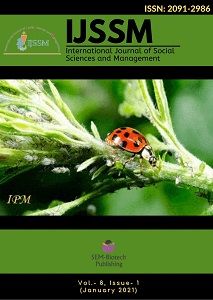Sustainable Livelihood Framework: Monitoring and Evaluation
DOI:
https://doi.org/10.3126/ijssm.v8i1.34399Keywords:
Indicators, Livelihood analysis, Monitoring, EvaluationAbstract
A livelihood comprises the capabilities, assets and activities required for a means of living. A livelihood is sustainable when it can cope with and recover from stresses and shocks and maintain or enhance its capabilities and assets both now and in the future, while not undermining the natural resource base. And The Framework used can be understood as a tool or checklist to understand poverty in responding to poor people’s views and their own understanding of poverty. In this context, a research was designed to study the sustainable livelihood framework: monitoring and evaluation. Different related of published and unpublished materials like books, research articles and other materials like package manuals were reviewed and the paper was prepared. The paper showed that, livelihood approaches are conceptual frameworks that promote people centered development. They are responsive and participatory, and they favor multidisciplinary and multilevel development interactions. Monitoring and evaluation must look beyond activity-based indicators of progress and resource-based definitions of change to measure achievements from the perspective of partners and beneficiaries. Livelihoods analysis helps us to address these assumptions as part of the project design. Assumptions can be ‘internalized’ either by including complementary activities (to cover ‘horizontal’ assumptions) or by linking projects up-stream and down-stream to ensure an appropriate enabling environment.
Int. J. Soc. Sc. Manage. Vol. 8, Issue-1: 266-271
Downloads
Downloads
Published
How to Cite
Issue
Section
License
This license enables reusers to distribute, remix, adapt, and build upon the material in any medium or format for noncommercial purposes only, and only so long as attribution is given to the creator.




